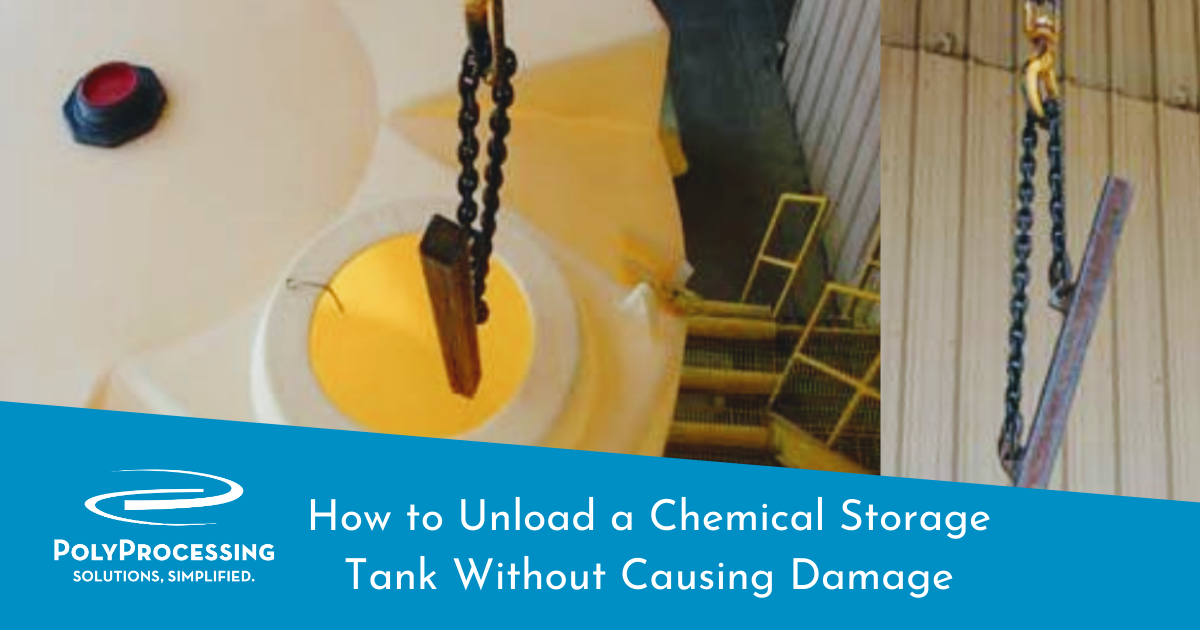How to Unload a Chemical Storage Tank Without Causing Damage
We’re obsessive about designing the proper tank for your particular chemical storage needs. But the right tank for the right job doesn’t matter if it isn’t offloaded and installed properly.

Unloading a storage tank from the trailer is no trivial matter. It’s critical to ensure that the tank isn’t damaged, and that your personnel and property are kept safe. Poly Processing provides a helpful offloading guide to ensure that your tank is offloaded successfully.
There’s no one way to offload every tank, every time. It often depends on where you’re going to set the tank and what kind of truck it came in on. But there are some basic instructions to follow when you’re unloading a tank.
Let’s go over a few key guidelines.
Safety First
Above all else, observe smart safety practices at all times. Improper and unsafe unloading can result in property damage, serious injury, or death. Keep personnel clear of the tank, rigging, and lift equipment.
Don’t stand or work on top of a polyethylene tank. The tank’s surfaces are flexible and slippery, which could cause a dangerous fall. The tank dome isn’t load rated, and it isn’t designed to support the weight of a person.
Whether you’re unloading or moving a tank, it must be fully drained before lifting.
Offloading Your Polyethylene Chemical Storage Tank
There are three basic approaches to offloading a Poly Processing tank from the truck. You can use:
- Lifting lugs
- Manway
- Forklift
Lifting by the Lifting Lugs
You can use a crane to lift the tank by its lifting lugs. Consult the tank drawing for the proper number of molded-in lifting lug sets to use during a lift. A set is a pair of molded lugs.
Be sure to use appropriate shackles. Shackles with a pin should be large enough to take up as much of the hole as possible to improve lifting control. Each shackle with a bolt and cable should have a lifting capacity of at least 3000 pounds.
If you’re lifting an insulated tank, be very careful to protect the foam surface at all times. Keep the protective wrapping on the tank until you’re done using cables and shackles.
When lifting the tank, be extremely careful to balance the weight of the tank.
Before setting an IMFO® tank flat on its own weight at any point during the off-loading process, a block (preferably a 12-in 4x4) must be set underneath the IMFO base to keep it off the ground.
Lifting by the Manway
Poly Processing strongly recommends the use of lifting lugs or truck straps underneath the tank to lift the tank. If neither of those is available, you can lift the tank by the manway. Insert a sturdy bar into the manway and position it horizontally, so that it acts like a handle from inside the tank. When you lift the bar, it will lift the tank as well.
Using a Forklift
If you don’t have a crane to lift the storage tank, you can use a forklift to offload it from the trailer.
Ensure the forklift tines are smooth and free from burrs, and use extended tines if you’re handling a large tank. Tie the tank to the forklift mast to prevent rolling or sliding.
As you lift the tank off of the trailer, be prepared to stop and adjust your load as necessary.
Slowly set the tank onto the floor in an unobstructed, flat area that allows the forklift to move around as needed. For insulated tanks, don’t remove the stretch wrap protecting until the tank is set in its final place.
You may want to use a second forklift to keep the tank steady as you position it in place. Adjust the forks of the second forklift so that they straddle the side of the upright tank. We recommend wrapping the forks in cardboard to prevent gouging.
These are important tips to offload your chemical storage tank safely and successfully. You can find step-by-step instructions in the Poly Processing Offloading Guide.
For more information about chemical storage tanks, talk to one of our chemical storage tank experts today.
- September 8, 2020
- Topics: Installation and Field Service, Chemical Storage
About Poly Processing
Posts By Topic
Tech Talk Podcast Episodes
Subscribe By Email
Recent Posts
- Installation Tips for Chemical Storage Tanks: Site Preparation and Offloading
- Understanding pH and Chemical Concentration When Choosing a Chemical Tank
- Maximizing Fill Efficiency: Selecting the Optimal Fill Line System
- Chemical Storage Tanks: A Quick Guide for End Users
- Popular Customization Options for Chemical Storage Tanks
Tank Configurator

Find the recommended tank and system components for your chemical storage challenge.
Configure a Tank Package




